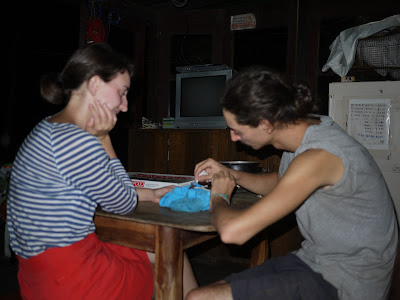Bats give most people a creepy feeling when they intrude into a certain safe-space that people have just for animals that could cause irreparable harm. Seeing bats up in the sky is generally acceptable, because most people have come to terms with bats being "up there" and doing the things bats do, for as long as anyone can remember. But
bats in the house, for instance, provoke a concern that comes from the subconscious, that is not easily controlled. Not even great admiration for Batman can dissolve the uneasiness they provoke.
Seeing a bat up close in a safe, controlled situation, however, usually works to endear people to them. Bats, after all, have faces, and they are small, and most of them, we know consciously, don't drink the blood of unfortunate humans. Most bats fall into one or another of three categories of diet: fruit, insects, and nectar. All of those bats provide tremendous environmental services that make our natural world work better. They keep down pesky insects, disperse seeds, and fertilize flowers.
We were recently blessed with a project - a juvenile Jamaican Fruit Bat (
Artibeus jamaicensis), not fully grown, that was found on the ground and would not fly. It would, however, drink and chew fruits. We at
Gaia decided we would take on the project to rescue and try to bring the bat back to a healthy animal, if there was something we could do.
 |
| This little guy did not want to fly, but readily drank milk. Photo Jeffrey McCrary |
The bat was still not nearly fully grown. As a mammal, it thoroughly enjoyed drinking milk, and it would suck on watermelon and other juicy fruits. We gave it plenty of food, at intervals of less than two hours over a ten-day period.
 |
| Eco-Warrior Volunteers diligently cared for the baby bat, feeding and cleaning the animal at frequent intervals. Photo Jeffrey McCrary. |
Our
Eco-Warrior Enviromental Volunteers were enthusiastic about the animal. The baby bat had all the expected basic, biological functions, but did not grow or get stronger, and eventually succumbed. Meanwhile, we learned a few things.
 |
| The bat readily sucked milk out of a cloth, but paper was more easily extracted from his mouth after a feeding. Photo Jeffrey McCrary. |
The first thing we learned, is that a bat is capable of responding positively to human attention and comfort. This little animal evidently enjoyed the attention and drank surprisingly large quantities at times. This all made us feel that the effort was not in vain. The bat did not live long, but it was not suffering and it even seemed to enjoy its life at moments.
 |
| Another feeding session with the baby bat. Photo Jeffrey McCrary. |
We also learned that we can try to do things that may not always succeed. Success is to often defined by the absence of failure. Even though we did not see the bat grow to an independent creature and fly away to live in the wild, we learned and gave, and this one bat also gained a benefit, by living comfortably a few more days. So, we are happy.
The attempted rescue of this little animal also gave us the opportunity to share with others the story of bats as beneficial creatures. Not all animals we rescue survive to return to the wild, but we try to give them all a chance to live and, if it happens, to die with dignity, especially those animals affected by humans. Some, but not all the stories of
wild animal rescue are positive, and some are downright tragic. All of us know, sadly, that the antagonistic relationship that humans sustain with wildlife requires new ways to engage people. We hope that this story reaches people who have not considered what happens to wildlife in the vicinity of humans. This little bat has gone on, but here, the story of this animal continues to reach people who may begin to consider that much of the harsh treatment toward wildlife is unnecessary and even counterproductive. Our staff, visitors, local neighbors and volunteers, and now, our readers can consider that even animals such as this little bat deserve both life and death with dignity.
 |
| A bat adorns the wall in Laguna de Apoyo. Photo Pablo Somarriba. |
We are engaged in different types of activities at
Gaia, not only wild animal rescue. Please read through our blog and visit us, to discuss with us the ways we can protect wild natural resources in Nicaragua. We hope you are engaged, too. If you would like to help us with cages, food, time, or money, to provide care for wild animals in distress, we would be grateful. Please
contact us or drop by at
Estación Biológica in
Laguna de Apoyo Nature Reserve, any time.
 |
| Click on the "escudo" to contact us. |






No comments:
Post a Comment